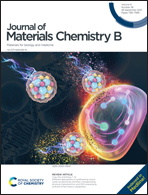High-energy-density shape memory materials with ultrahigh strain for reconfigurable artificial muscles†
Abstract
Programmable and reconfigurable artificial muscles are highly promising and desirable for applications in various fields, including soft robotics, flexible devices, and biomedical devices. However, the combination of considerable strain and high energy density remains a dilemma to overcome. As stimulus-responsive polymers, shape memory polymers (SMPs) with enhanced mechanical properties and programmability have the potential to solve this problem. However, the purest shape memory polymer lacks reconfigurability, and it is challenging to achieve precise control due to its intrinsic thermal stimulation. Herein, we report a novel reconfigurable multi-block shape memory polymer and its composite with a granular micro-phase separated structure. The polymer demonstrated outstanding artificial muscle performance through the energy storing and releasing method, whose energy density and strain reached 717.8 kJ m−3 and 947%, respectively (17.9 and 23.7 times higher than that of mammalian skeletal muscles). Moreover, by incorporating Fe3O4 nanoparticle (Fe3O4 NP) photothermal transducers, the composite could achieve contraction, reversible muscle-like bending and complex programmable and reconfigurable deformation under near-infrared laser irradiation, including deformation into a specific letter shape, precise origami and bending with loads. Therefore, the prepared materials have excellent prospects as artificial muscles and high-power actuators for broad applications.



 Please wait while we load your content...
Please wait while we load your content...